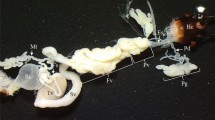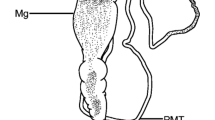Abstract
Calosoma sycophanta L. is a voracious predatory beetle that feeds on several important lepidopteran pests such as the gypsy moth (Lymantria dispar L.), the brown-tail moth (Euproctis chrysorrhoea L.) and the pine processionary moths (Thaumetopoea pityocampa). It is mass reared in laboratory breeding and released against forest pests. So, C. sycophanta are important predators with the potential to be used in the biological control in agriculture. Although some studies provide important data on the gut anatomy in Carabidae, they are limited to few species. In the present study, we investigated the structure of the Malpighian tubules and digestive tract by means of light and electron microscopies. According to the results obtained, in C. sycophanta, the digestive tract consists of 3 basic parts: foregut, midgut and hindgut. The foregut consists of the oral cavity, pharynx, esophagus, crop, and proventriculus. The esophagus is tubular and has a convoluted surface. Crop bulb-like is an enlarged channel. The proventriculus is connected to the mid-gut. The midgut extends from the foregut at the anterior end to the hindgut at the posterior end. Midgut surface is densely covered with crypts which is finger-shaped. The hindgut consists of the ileum, the colon and the rectum. The anterior end of ileum is marked by the entrance of the four Malpighian tubules. Malpighian tubules are surrounded by a monolayer cubic epithelium. Colon is located between the posterior end of the ileum and the anterior of the rectum. The rectum is lined lumen, intima, a single layer convoluted epithelium and a muscle layer. In addition, in this species, a pair of anal gland, anal gland reservoir and thin-long reservoir ducts are connected with the genital chamber. These data are discussed in comparison with the digestive tract in other Coleopteran species.










Similar content being viewed by others
References
Aldigail SA, Alsaggaff AI, Al-Azab AM (2013) Anatomical and histological study on the digestive canal of Epilachna chrysomelina (Coleoptera: Coccinellidae). Biosci Biotechnol Res 10(1):183–192
Ali HA (1964) An introduction to the taxonomy of Iraqi Carabidae Col., with an examination of the taxonomic value of internal characters. Imperial College of Science and Technology, Department of Zoology and Applied Entomology, South Kensington, London
Ameen M, Shafiq SA (1959) Proepithelial regeneration in the midgut of beetles. Nature 183(4665):913–914
Avtzis ND (1998) The use of Bacillus thuringiensis against Thaumetopoea pityocampa Schiff. (Lepidoptera: Thaumetopoeidae) in Greece. Proceedings of population dynamics, impacts and integrated management of forest defoliating insects, USDA Forest Service, General Technical Report NE-247, 311–316
Babur H (2002) The effect of damage of Thaumetopoea pityocampa (Schiff.) in Calabrian pine seedling in Turkey, In: Kanat M (ed) Proceedings of pine processionary moth symposium, Kahramanmarafl-Turkey, pp. 37-38
Barratt BIP, Moran VC, Bigler F, Van Lenteren JC (2018) The status of biological control and recommendations for improving uptake for the future. BioControl 63(1):155–167
Bess HA (1935) The alimentary canal of Calosoma sycophanta Linnaeus. Ohio J Sci 35:54–61
Borges I, Nóia M, Camarinho R, Rodrigues AS, Soares AO (2015) Characterization of the alimentary canal of the aphidophagous ladybird, Adalia bipunctata (Coleoptera: Coccinellidae): anatomical and histological approaches. Entomol Sci 18(1):66–73
Bousquet Y (2012) Catalogue of Geadephaga (Coleoptera, Adephaga) of America, north of Mexico. ZooKeys 245:1–1172
Bu SH, Chen H (2009) The alimentary canal of Dendroctonus armandi Tsai and Li (Coleoptera: Curculionidae: Scolytinae). Coleopt Bull 63(4):485–496
Buxton RD (1983) Forest management and the pine processionary moth. Outlook Agr 12:34–39
Candan S, Özyurt Koçakoğlu N, Erbey M (2019) Morphology and histology of the alimentary canal of Epiphaneus malachiticus Boheman, 1842 (Coleoptera, Curculionidae). Entomol Rev 99(3):326–336
Chapman RP (1969) The insects. Structure and function. Hodder and Stoughton, London
Characaras C (1981) Etude du comportement nutritionnel et de la digestion chez cer- tains Cerambycidae xylophages. Mater Org 16(3):207–240
Cheeseman MT, Pritchard G (1984) Proventricular trituration in adult carabid beetles (Coleoptera: Carabidae). J Insect Physiol 30(3):203–209
Chocorosqui VR, Pasini A (2000) Predação de pupas de Alabama argillacea (Hübner) (Lepidoptera: Noctuidae) por larvas e adultos de Calosoma granulatum Perty (Coleoptera: Carabidae) em Laboratório. An Soc Entomol Bras 29(1):65–70
Crowson RA (1981) The biology of the Coleoptera. Academic Press, London 3:76–118
De Sousa G, Scudeler EL, Abrahão J, Conte H (2013) Functional morphology of the crop and proventriculus of Sitophilus zeamais (Coleoptera: Curculionidae). Ann Entomol Soc Am 106(6):846–852
Edmonds WD (1974) Internal anatomy of Coprophanaeus lancifer (L.) (Coleoptera: Scarabaeidae). Int J Insect Morphol Embryol 3:257–272
Erwin TL (1985) The taxon pulse: a general pattern of lineage radiation and extinction among carabid beetles. In: Ball GE (ed) Taxonomy, phylogeny and biogeography of beetles and ants, Dordrect, The Netherlands pp. 437–488
Forsythe TG (1982) Feeding mechanisms of certain ground beetles (Coleoptera: Carabidae). Coleopts Bull 26–73
Gillott C (2005) Entomology. Springer science and business media, Third edition, The Netherlands
Halffter G, Edmonds WD (1982) The nesting behavior of dung beetles (Scar- abaeinae): an ecological and evolutive approach. Instituto de Ecologia Mexico 10:1–176
Halffter G, Matthews E (1966) The natural history of dung beetles of the subfamily Scarabaeinae (Coleoptera, Scarabaeidae). Folia Entomol Mex 12-14:1–312
Ingerson-Mahar JM (2014) Relating diet and morphology of the head, mandibles and proventriculus in adult carabid beetles, Doctoral dissertation, Graduate School-New Brunswick
Jaspar-Versali MF, Goffinet G, Jeuniaux C (1987) The digestive system of adult carabid beetles: an ultrastructural and histoenzymological study. Acta Phytopath Entom Hung 22(1–4):375–382
Kanat M (2002) Çam Keseböceği (Thaumetopoea pityocampa Schiff.)‘ne karşı biyolojik mücadelede Calosoma sycophanta L.’nın kullanımı. In: Proceedings of pine processionary moth symposium, Kahramanmaraş, Turkey. pp. 93–101
Kanat M, Sivrikaya F, Serez M (2002) A research on damage of pine processionary moth (Thaumetopoea pityocampa Schiff.) on Pinus brutia Ten. trees, and the effect of tending activities on the diameter increment of Calabrian pine in Kahramanmaraş. In: Kanat M (ed) Proceedings of pine processionary moth symposium Kahramanmarafl, Turkey, pp. 44-51
Kanat M, Toprak Ö, Akbulut S (2005) Determination of some biological characteristics of Calosoma sycophanta (italik) L.(Coleoptera: Carabidae). Turk J Zool 29(1):71–75
Lightle PC, Weiss MJ (1974) Dwarf misletoe of ponderosa pine in the Soutwest U.S, Departmant of agriculture forest service, forest insect and disease leaflet, United States 19:1–7
Lövei GL, Sunderland KD (1996) Ecology and behavior of ground beetles (Coleoptera: Carabidae). Annu Rev Entomol 41:231–236
Luff ML (1987) Biology of polyphagous ground beetles in agriculture. Agric Zool Rev 2:237–278
Lyytikainen-saarenmaa P (1999) Growth responses of scots pine (Pinacae) to artificial and sawfly (Hymenoptera: Diprionidae) defoliation. Can Entomol 131:455–463
Maddrell SHP (1972) The mechanisms of insect excretory systems. In advances in insect physiology. Academic Press 8:199–331
Markalas S (1985) Observations on the biology, the behavior and the damage caused by the pine processionary moth (Thaumetopoea pityocampa Schiff.), Aristotelian University of Thessalonici. Sc Ann Depart Forestry and Nat Environ 28:303–370
Markalas S (1986) Problems on the control of the pine processionary moth. Proceeding of the symposium protection of forests, Hellenic For Soc Athens, pp. 85–88
Markalas S (1989) Influence of the attack by Thaumetopoea pityocampa Schiff. on the height increment of young pine tress, Aristotelian University of Thessalonici. Sc Ann Depart Forestry and Nat Environ 32:177–195
Matta DHD, Cividanes FJ, Silva RJ, Batista MN, Otuka AK, Correia ET, Matos STS (2017) Feeding habits of Carabidae (Coleoptera) associated with herbaceous plants and the phenology of coloured cotton. Acta Sci Agron 39(2):135–142
Nation JL (1983) A new method using hexamethyldisilazane for preparation of soft insect tissues for scanning electron microscopy. Stain Technol 58:347–351
Ogurlu I (2000) Biyolojik mücadele. SDÜ Orman Fakültesi Yayını, Isparta, Turkey. Physiology 8:199–331
Poll M (1932) Contribution a l'etude des tubes de Malpighi des Coleopteres. Leur utilite en phylogenese. Recueil de l'Institut Zoologique Torley-Rousseau 4:47–80
Rive JL (1966) Thaumetopoea pityocampa. Biology and control, Note Inst Rebois, No. 5, Tunis
Rubio JDG, Bustillo PAE, Vallejo ELF, Acuña ZJR, Benavides MP (2008) Alimentary canal and reproductive tract of Hypothenemus hampei (Ferrari) (Coleoptera: Curculionidae, Scolytinae). Neotrop Entomol 37(2):143–151
Sarwade AB, Bhawane GP (2013) Anatomical and histological structure of alimentary canal of adult Platynotus belli (Coleoptera: Tenebrionidae). BFAIJ 5:47–55
Schafer PW, Fuester RW, Barth PE, Simons EE, Blumenhal EM, Handley EM, Finn TB, Elliott EW (1999) Current distribution and historical range expansion of Calosoma sycophanta (Coleoptera: Carabidae) in North America. J Entomol Sci 34:339–362
Singh OL, Prasad B (2013) Histomorphology of the alimentary tract of adult, Odoiporus longicollis (Oliv.) (Coleoptera: Curculionidae). J Entomol Res Soc 1:109–115
Smith DS (1968) Insect cells: their structure and function. Oliver and Boyd, Edinburgh
Snodgrass RE (1935) Principles of insect morphology. McGraw-Hill, New York
Thiele HU (1977) Carabid beetles in their environments. A study on habitat selection by adaptations in physiology and behaviour. Springer Verlag, Berlin
Tiberi R, Niccoli A, Curini M, Epifano F, Marcotullio MC, Rosati O (1999) The role of the monoterpene in Pinus spp. needles, in host selection by the pine processionary moth, Thaumetopoea pityocampa. Phytoparasitica 27:263–272
Tosun İ (1977) Akdeniz Bölgesi iğne yapraklı ormanlarında zarar yapan böcekler ve önemli türlerin parazit ve yırtıcıları üzerinde araştırmalar. Ph D thesis, Faculty of Forestry University of İstanbul, İstanbul, 149 pp
Umeya K (1960) A comparative morphology of the alimentary tract in the adults of lamellicorn-beetles (Coleoptera). Mem Facult Agricult Hokkaido Univ 3:60–113
Vazquez-Arista M (1997) Anatomical, enzymatic, and microbiological studies on the digestive system of Prostephanus truncatus (Horn), Doctoral thesis, University of Leicester, England
Weseloh R, Bernon G, Butler L, Fuester R, Mccullough D, Stehr F (1995) Releases of Calosoma sycophanta (Coleoptera: Carabidae) near the edge of gypsy moth (Lepidoptera: Lymantriidae) distribution. Environ Entomol 24(6):1713–1717
Whittington FB (1935) The alimentary canal of Harpalus pennsylvanicus Dej. (Carabidae: Coleoptera). Ohio J Sci 35(2):131–138
Wigglesworth VB (1932) Memoirs: on the function of the so-called ‘rectal glands’ of insects. J Cell Sci 2(297):131–150
Wyckhuys KAG, O’neil RJ (2006) Population dynamics of Spodoptera frugiperda Smith (Lepidoptera: Noctuidae) and associated arthropod natural enemies in Honduran subsistence maize. Crop Prot 25(11):1180–1190
Acknowledgments
We thank Gazi Üniversity Academic Writing Center for revising the grammar of this article.
Author information
Authors and Affiliations
Corresponding author
Ethics declarations
Additional information
This article was originally submitted by the author in English and has not been submitted for publication elsewhere.
Additional information
Publisher’s note
Springer Nature remains neutral with regard to jurisdictional claims in published maps and institutional affiliations.
Rights and permissions
About this article
Cite this article
Candan, S., Özyurt Koçakoğlu, N. & Serttaş, A. Histoanatomy of Malpighian tubules and the digestive tract of adult of biocontrol agent Calosoma sycophanta L. (Coleoptera: Carabidae). Int J Trop Insect Sci 41, 1373–1386 (2021). https://doi.org/10.1007/s42690-020-00331-4
Received:
Accepted:
Published:
Issue Date:
DOI: https://doi.org/10.1007/s42690-020-00331-4




